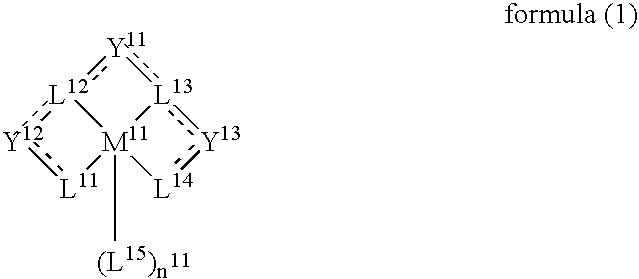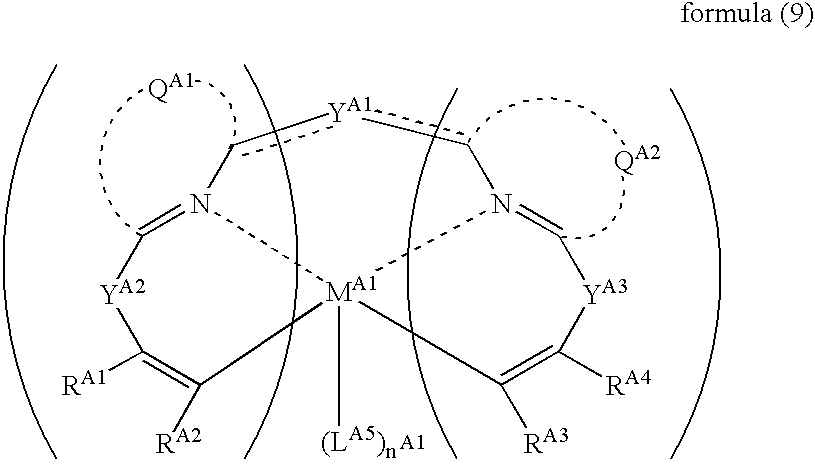Organic electroluminescent devices and metal complex compounds
a technology of electroluminescent devices and complex compounds, applied in the direction of discharge tube luminescnet screens, natural mineral layered products, other domestic articles, etc., can solve the problems of complexes that cannot meet both durability and luminous characteristics
- Summary
- Abstract
- Description
- Claims
- Application Information
AI Technical Summary
Problems solved by technology
Method used
Image
Examples
example 1
[0213] A cleaned ITO substrate was placed in a vacuum evaporator, and onto the substrate TPD (N,N-diphenyl-N,N-di(m-tolyl)benzidine) was evaporated to form a film having a thickness of 50 nm, then Compound (1) according to the present invention and Compound A (a ratio by mass of 1:17) were co-evaporated to form a film having a thickness of 36 nm, and then Compound B was evaporated to form a film having a thickness of 36 nm. Then, a patterned mask (for adjusting each emission area to 4 mm×5 mm) was set on the organic thin layers, and further thereon, inside the vacuum evaporator, lithium fluoride was evaporated to form a film having a thickness of 3 nm, followed by deposition of a 400 nm-thick aluminum film.
[0214] The thus produced EL device was subjected to luminescence by applying thereto a DC constant voltage by means of a source measure unit, Model 2400 (trade name), made by Toyo Technica Co., Ltd. and the luminance that the EL device showed was measured using a luminometer BM-8...
example 2
[0215] A cleaned ITO substrate was placed in a vacuum evaporator, and onto the substrate TPD (N,N-diphenyl-N,N-di(m-tolyl)benzidine) was evaporated to form a film having a thickness of 50 nm, then Compound (1) according to the present invention and Compound A (a ratio by mass of 1:2) were co-evaporated to form a film having a thickness of 36 nm, and then Compound B was evaporated to form a film having a thickness of 36 nm in this order. Then, a patterned mask (for adjusting each emission area to 4 mm×5 mm) was set on the organic thin layers, and further thereon, inside the vacuum evaporator, lithium fluoride was evaporated to form a film having a thickness of 3 nm, followed by deposition of a 400 nm-thick aluminum film.
[0216] The thus produced EL device was subjected to luminescence by applying thereto a DC constant voltage by means of a source measure unit, Model 2400 (trade name), made by Toyo Technica Co., Ltd. and the luminance that the EL device showed was measured using a lum...
example 3
[0219] A luminescent layer was formed in the same manner as in Comparative Example 3, except for changing the film thickness of host to 36 nm. Thereon, compound B was evaporated to form an electron-transporting layer having a thickness of 36 nm. Then, a patterned mask (for adjusting each emission area to 2 mm×2 mm) was set on the organic thin layers, and further thereon, inside the vacuum evaporator, lithium fluoride was evaporated to form a film having a thickness of 5 nm, followed by deposition of a 500 nm-thick aluminum film. Subsequently, the device was sealed after incorporation of a drying agent therein, to prepare an EL device (Device No-104). In addition, another EL device (Device No-105) was prepared in the same manner as described above, except that the host material was replaced with Compound A.
PUM
| Property | Measurement | Unit |
|---|---|---|
| temperature | aaaaa | aaaaa |
| temperature | aaaaa | aaaaa |
| temperature | aaaaa | aaaaa |
Abstract
Description
Claims
Application Information
 Login to View More
Login to View More - R&D
- Intellectual Property
- Life Sciences
- Materials
- Tech Scout
- Unparalleled Data Quality
- Higher Quality Content
- 60% Fewer Hallucinations
Browse by: Latest US Patents, China's latest patents, Technical Efficacy Thesaurus, Application Domain, Technology Topic, Popular Technical Reports.
© 2025 PatSnap. All rights reserved.Legal|Privacy policy|Modern Slavery Act Transparency Statement|Sitemap|About US| Contact US: help@patsnap.com



